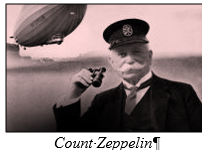Background
In the early years of the 20th Century in a
parallel universe (two to the left, four back and three clockwise) the German
Kaiser took a fateful decision that would change the course of history. After a
meeting with his navy chiefs, when he heard of the new British dreadnoughts
that completely outclassed his navy and how much money it would cost to rebuild
his navy to match the British, he was depressed, but still decided to go out to
lunch with Count Zeppelin (The Count was paying).

At lunch the Count expanded on his new idea that ships and navies where soooo 19th Century and that the future belonged to the country who controlled the skies. The Kaiser went back to his palace reinvigorated, with his head held high, a smile on his face, a full stomach and the satisfaction of leaving the Count to settle a substantial bill.
The next day the Berlin Times carried the following headline “GERMAN NAVY FOR SALE!” and then below it: “Kaiser Announces New Zeppelin Force To Control the Skies - Deutsche Luft Korp”.
It went on with a quote from the Kaiser “The British can keep
the oceans – Germany will own the skies! We don't need to go through them, we
can just fly straight over.” The Kaiser was praised across the world for his
peacemaking efforts in stopping the naval arms race.
 The
French Ambassador immediately cabled Paris and the French Military high command
heaved a sigh of relief. Now they would have the time to re-build the army they
had dreamed of. Based on the lessons of 1870 and on their observations of the
1905 Japanese Russian war and with the technology of today – it would be an
army designed as pure offensive "guerre
à outrance" and they would show the world
and Germany how to wage war. They announced their new doctrine - “La Guerre
éclair” – lighting war. They chuckled to themselves and called in the engineers
and designers.
The
French Ambassador immediately cabled Paris and the French Military high command
heaved a sigh of relief. Now they would have the time to re-build the army they
had dreamed of. Based on the lessons of 1870 and on their observations of the
1905 Japanese Russian war and with the technology of today – it would be an
army designed as pure offensive "guerre
à outrance" and they would show the world
and Germany how to wage war. They announced their new doctrine - “La Guerre
éclair” – lighting war. They chuckled to themselves and called in the engineers
and designers. That day when the news reached London, the Admiralty cheered
and went for dinner early and the champagne and port flowed freely into the
night. The admirals' laughter filled the Navy Club's dining room. How could a
German Zeppelin match a destroyer let alone a battleship of the Dreadnought
Class , and they laughed at how one of those new fangled air planes would just
bounce off the armour and leave a nasty oil stain for the sailors to clean. “Put
in an order for extra detergent!” yelled an Admiral to much laughter.
That day when the news reached London, the Admiralty cheered
and went for dinner early and the champagne and port flowed freely into the
night. The admirals' laughter filled the Navy Club's dining room. How could a
German Zeppelin match a destroyer let alone a battleship of the Dreadnought
Class , and they laughed at how one of those new fangled air planes would just
bounce off the armour and leave a nasty oil stain for the sailors to clean. “Put
in an order for extra detergent!” yelled an Admiral to much laughter.
But in the following week, after the hangovers and laughter
were gone, during a discussion on budgets for the next few years the enormity
of the Kaiser's decision suddenly hit home – no German Navy meant a much, MUCH
smaller British navy. NO new Battleships! A naval building program that
required a navy that was larger than the next two largest fleets combined was
no good when those two fleets only had one old battleship each. Something would
have to be done, and done soon, before the parliament worked out the
implications – careers were at stake!
Luckily, the fertile mind of First Sealord Churchill sprang into action and, with a little help from Mr. HG Wells and a few ingenious engineers, produced Landships. Ships of the Line that would track across the land carrying all before them just like battleships at sea. Finally the British Navy would really control the world. Code named “Tanks” to hide the program from the army until they were well underway, the Navy took to the land.
With the end of the
battleship arms race, each country had plenty of money to spend on their
favourite weapons and in just a decade's time after the factories had worked
overtime, they were all ready and willing to test them out.

 Thus the arms race was changed forever and history branched
off in a new direction, but it still was marching to war.
Thus the arms race was changed forever and history branched
off in a new direction, but it still was marching to war.The question was never “if” there would be a war but only where and when.

The Battle for Belgium began!
In the sepia
tones of the early 20th Century, there was only WAR!



No comments:
Post a Comment